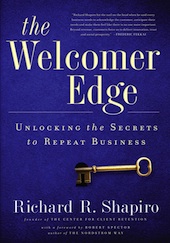What’s the sincerity level of your message?
When someone tells me to “Have a nice day,” I don’t think they mean it. I think they’re just saying it as a kind of mundane, almost impolite, form of politeness. Forced nicety. Said out of habit, not sincerity. To me, it’s not just thoughtless, it’s also meaningless. Heck, half the time people don’t even look at you when they say it.
Oh, they don’t mean it as an insult. People say, “Have a nice day,” because they don’t know what else to say. Or don’t care what they say. Or they are trained to say it.
But think about it. Do they only mean THAT day? Do they want me to have a crappy tomorrow? Or they will go so far as to say, “Have a good rest of the week.” What does that mean, I’m going to have a horrible weekend? Or month? Or year? Or life?
If you are going to say something to me, or your customer, make it sincere, make it meaningful, and make it relevant. Otherwise, I mentally check you off – the same way you check people off. And the question here is, are you being checked off?
Consistency of message and expression is important – but NOT ROBOTIC.
Give people leeway to be human.
Boring and insincere typically has a way of permeating everything else in a company. The color of your logo.
- The politically correctness of your slide show.
- The stuffiness of your business card.
- The boringness of your job title.
Who cares? ONLY YOU! (Your marketing people, your ad agency, yada, yada) Anyone preparing “boring” marketing tools in this day and age should be forced to take that crap out on a sales call and see how CUSTOMERS perceive it or care ten cents about it.
The key word is SINCERITY.
The secondary word is DIFFERENTIATION.
Here are some GOLDEN opportunities to be creatively sincere:
- At the fast food window
- When customers walk in your store
- When customers pay for something
- When customers board the plane
- When customers are about to order in a restaurant
- When customers are sent an invoice
These are all opportunities to prove differentiation, be sincere, and even WOW the customer.
- Marketing and HR people: Get off your corporate hobby horse and saddle up your creative brain!
- Employees: You’re an individual, not some kind of automated answering device. (Don’t get me started. Reality, if my call is so darn important, DO SOMETHING ABOUT IT, don’t tell me about it.) Use your friendliness and creativity to craft a message that the customer perceives as real.
FORCED CORPORATE POLITENESS: I love it when service reps or managers candidly you’re your piece, the other person is clearly wrong, won’t admit it, but are under corporate edict to be polite, but you know they hate you, and their life when they tersely ask, “Will there be anything else?” Makes me smile and feel sad all at once.
Southwest Airlines is anything but politically correct. Their people are happy, their customers are happy, their message is clear, and they make a TON of money. Jeez, I wonder if there’s a correlation!
What about you? How sincere are you?
Here are 4 things you can do tomorrow without anyone’s permission:
- Look me in the eye. Make sure there’s a locked-in moment
- Say something slightly different. “You’re all set.” vs. “Thanks for your business.”
- Shake my hand like you mean it. Firm, with eye contact.
- Smile. When you smile, it makes others smile.
IDEA: Make a goal to create 12 smiles a day through your words, actions or deeds. Creativity and sincerity will automatically materialize.
Have a nice day!
Reprinted with permission from Jeffrey H. Gitomer and Buy Gitomer.
About the Author


